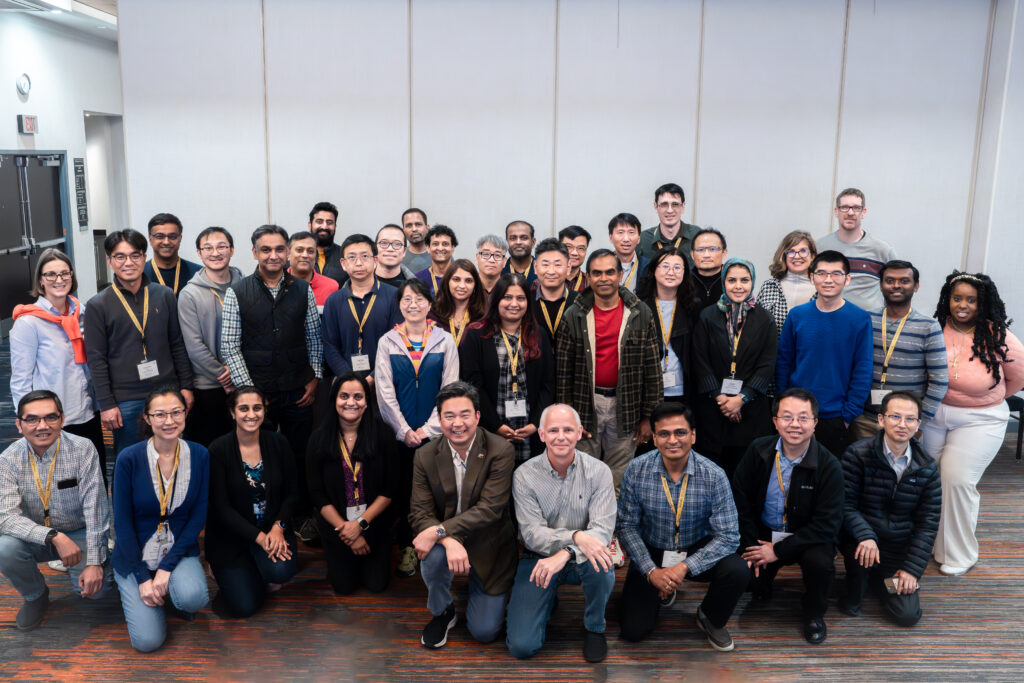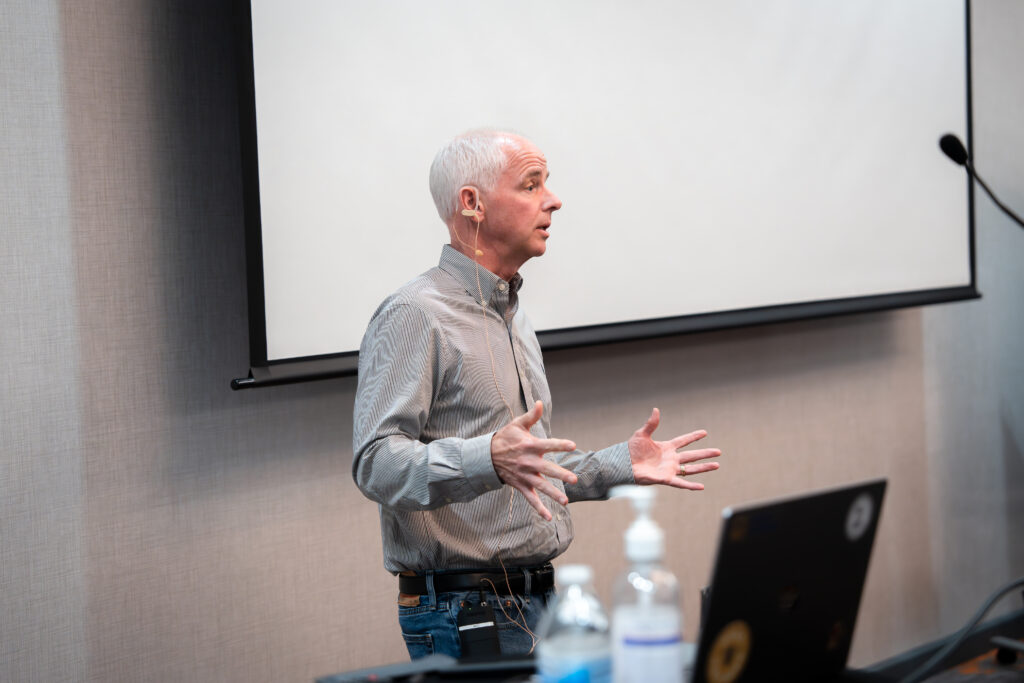Innovation and Engineering Leadership with Marc Tarpenning, Co-Founder, Tesla Inc.
For over a decade, the Sutardja Center for Entrepreneurship & Technology (SCET) at UC Berkeley has hosted the Engineering Leadership Professional Program (ELPP), which has helped more than 1,000 technical professionals hone their leadership skills and bring an innovative spirit to their firms.
On February 28, Marc Tarpenning (B.A. Computer Science ‘85), co-founder of Tesla Inc. was a guest lecturer at this year’s ELPP. He is also a member of the advisory board at SCET, and he spends his time investing and advising entrepreneurs and innovators who will make a positive impact with their ventures.
From Inception to Industry Leader
Today, it is clear that electric vehicles are the future. In 2024, there is fierce competition among the likes of Tesla, established players like Ford and General Motors, and newcomers like China’s BYD.
However, in 2003, when Marc Tarpenning and Martin Eberhard co-founded Tesla Inc., many were skeptical of electric vehicles’ potential to be the future of the auto industry. According to Tarpenning, existing electric cars were “designed by people who hated the idea of driving.”
“We went looking for a problem,” said Tarpenning at the beginning of his talk. “And that’s a real sign of an entrepreneur when you go looking for a problem. Because most people don’t actually do that.”
Tarpenning and Eberhard wanted to work on the problem of oil. Not only is oil one of the primary factors contributing to global warming, but the conflict for this increasingly scarce resource has distorted the global economy and spurred various geopolitical issues across the world.
At the time, nearly zero electric cars had been sold in the US. Companies argued that its nonexistence was attributed to the inadequate capabilities of batteries, which had not evolved enough in the past century. However, Tarpenning and Eberhard, who both have backgrounds in consumer electronics, immediately identified faults in this reasoning. After researching various power sources, including hydrogen and ethanol alternatives, they settled on batteries, which were getting cheaper and more powerful by the year. Battery electric vehicles were more efficient than an internal combustion engine. People didn’t need fossil fuels to drive their cars. They just needed a way to recharge cells like this and they could do this from home.
“Every year [batteries] got better and cheaper,” said Tarpenning. “So, we knew that if we could make a compelling car, with this existing technology, every year it would just get better and cheaper.”
Tarpenning and Eberhard realized the incredible opportunity to revolutionize the automobile industry and got to work. For the initial car, they did not want to develop a specialty battery but rather use off-the-shelf 18650 lithium-ion batteries for each car. Each car required approximately 7,000 rechargeable batteries. While this decision increased the complexity of the assembly procedure, it gave them major advantages with supply chain efficiency and allowed them to purchase batteries at lower prices. They didn’t use fancy mathematics but just “spreadsheets and high school math” to calculate the amount of power and energy they could generate with their setup.
Amazingly, the latest Tesla concept car will go 0 to 60 in 1.78 seconds which is exactly what the spreadsheet predicted more than 20 years ago. “Mathematics and physics work. $70M later it was just like the spreadsheet said,” said Tarpenning. “Physics is crazy.”
Around the same time, General Motors debuted its popular all-electric car called the EV1. Additionally, the Prius was launched and began selling quite well. One interesting finding was that Toyota built the original Prius on their Echo platform, their lowest quality platform, and were losing money on each one they produced. Some consumers who would have bought a Lexus were instead buying the Prius (e.g. Larry David anyone?). Perhaps wealthier individuals also wanted to tackle the problem of oil, which was a positive sign for selling an all-electric sports car.
Initially, Tarpenning and Eberhard intended to enter the sports car market, which was a $3B market in the US at the time. However, since close to zero electric cars had been sold in the US, they instead deferred to creating passenger cars, an industry in which their innovations had more potential to take flight.
The next six months were focused on the company’s go-to-market strategy, and the team needed to raise money. Funding is like a positive feedback loop – each milestone raises more money, helping the company achieve even more ambitious milestones. After thousands of design changes and tests, some of the cars began selling at small events, helping the company increase visibility and gain traction. In 2010, Tesla became a public company. In 2024, Tesla is worth more than General Motors and Ford combined. Tarpenning and Eberhard were right. Their vision of electric cars proved to be the future – electric vehicles are the only growth segment in the car market at a rate of 52%.

Tarpenning’s Pearls of Wisdom
Today, Marc Tarpenning is a venture capitalist. He emphasized investing in companies that make a positive impact and have a particular interest in creating a more sustainable world.
He said, “If you aren’t doing something sustainable as a company, then it’s going to stop, by definition. Maybe it will be 100 years or maybe it will be soon. The future is really hard to predict.”
Interested in learning more from speakers like Marc? Check SCET Professional Programs for information on when the next ELPP cohort begins.
For over a decade, the Sutardja Center for Entrepreneurship & Technology (SCET) at UC Berkeley has hosted the Engineering Leadership Professional Program (ELPP), which has helped more than 1,000 technical professionals hone their leadership skills and bring an innovative spirit to their firms.
On February 28, Marc Tarpenning (B.A. Computer Science ‘85), co-founder of Tesla Inc. was a guest lecturer at this year’s ELPP. He is also a member of the advisory board at SCET, and he spends his time investing and advising entrepreneurs and innovators who will make a positive impact with their ventures.
From Inception to Industry Leader
Today, it is clear that electric vehicles are the future. In 2024, there is fierce competition among the likes of Tesla, established players like Ford and General Motors, and newcomers like China’s BYD.
However, in 2003, when Marc Tarpenning and Martin Eberhard co-founded Tesla Inc., many were skeptical of electric vehicles’ potential to be the future of the auto industry. According to Tarpenning, existing electric cars were “designed by people who hated the idea of driving.”
“We went looking for a problem,” said Tarpenning at the beginning of his talk. “And that’s a real sign of an entrepreneur when you go looking for a problem. Because most people don’t actually do that.”
Tarpenning and Eberhard wanted to work on the problem of oil. Not only is oil one of the primary factors contributing to global warming, but the conflict for this increasingly scarce resource has distorted the global economy and spurred various geopolitical issues across the world.
At the time, nearly zero electric cars had been sold in the US. Companies argued that its nonexistence was attributed to the inadequate capabilities of batteries, which had not evolved enough in the past century. However, Tarpenning and Eberhard, who both have backgrounds in consumer electronics, immediately identified faults in this reasoning. After researching various power sources, including hydrogen and ethanol alternatives, they settled on batteries, which were getting cheaper and more powerful by the year. Battery electric vehicles were more efficient than an internal combustion engine. People didn’t need fossil fuels to drive their cars. They just needed a way to recharge cells like this and they could do this from home.
“Every year [batteries] got better and cheaper,” said Tarpenning. “So, we knew that if we could make a compelling car, with this existing technology, every year it would just get better and cheaper.”
Tarpenning and Eberhard realized the incredible opportunity to revolutionize the automobile industry and got to work. For the initial car, they did not want to develop a specialty battery but rather use off-the-shelf 18650 lithium-ion batteries for each car. Each car required approximately 7,000 rechargeable batteries. While this decision increased the complexity of the assembly procedure, it gave them major advantages with supply chain efficiency and allowed them to purchase batteries at lower prices. They didn’t use fancy mathematics but just “spreadsheets and high school math” to calculate the amount of power and energy they could generate with their setup.
Amazingly, the latest Tesla concept car will go 0 to 60 in 1.78 seconds which is exactly what the spreadsheet predicted more than 20 years ago. “Mathematics and physics work. $70M later it was just like the spreadsheet said,” said Tarpenning. “Physics is crazy.”
Around the same time, General Motors debuted its popular all-electric car called the EV1. Additionally, the Prius was launched and began selling quite well. One interesting finding was that Toyota built the original Prius on their Echo platform, their lowest quality platform, and were losing money on each one they produced. Some consumers who would have bought a Lexus were instead buying the Prius (e.g. Larry David anyone?). Perhaps wealthier individuals also wanted to tackle the problem of oil, which was a positive sign for selling an all-electric sports car.
Initially, Tarpenning and Eberhard intended to enter the sports car market, which was a $3B market in the US at the time. However, since close to zero electric cars had been sold in the US, they instead deferred to creating passenger cars, an industry in which their innovations had more potential to take flight.
The next six months were focused on the company’s go-to-market strategy, and the team needed to raise money. Funding is like a positive feedback loop – each milestone raises more money, helping the company achieve even more ambitious milestones. After thousands of design changes and tests, some of the cars began selling at small events, helping the company increase visibility and gain traction. In 2010, Tesla became a public company. In 2024, Tesla is worth more than General Motors and Ford combined. Tarpenning and Eberhard were right. Their vision of electric cars proved to be the future – electric vehicles are the only growth segment in the car market at a rate of 52%.

Tarpenning’s Pearls of Wisdom
Today, Marc Tarpenning is a venture capitalist. He emphasized investing in companies that make a positive impact and have a particular interest in creating a more sustainable world.
He said, “If you aren’t doing something sustainable as a company, then it’s going to stop, by definition. Maybe it will be 100 years or maybe it will be soon. The future is really hard to predict.”
Interested in learning more from speakers like Marc? Check SCET Professional Programs for information on when the next ELPP cohort begins.


